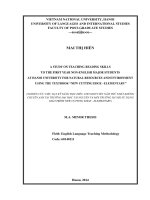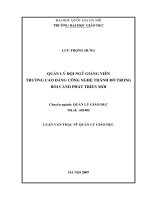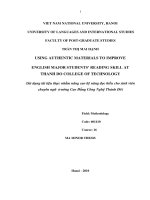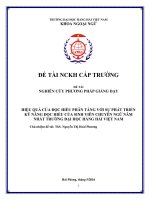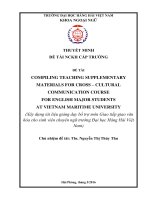Sử dụng tài liệu thực nhằm nâng cao kỹ năng đọc hiểu cho sinh viên chuyên ngữ trường Cao đẳng Công nghệ Thành Đô
Bạn đang xem bản rút gọn của tài liệu. Xem và tải ngay bản đầy đủ của tài liệu tại đây (829.03 KB, 69 trang )
1
VIET NAM NATIONAL UNIVERSITY, HANOI
UNIVERSITY OF LANGUAGES AND INTERNATIONAL STUDIES
FACULTY OF POST-GRADUATE STUDIES
TRẦN THỊ MAI HẠNH
USING AUTHENTIC MATERIALS TO IMPROVE
ENGLISH MAJOR STUDENTS’ READING SKILL AT
THANH DO COLLEGE OF TECHNOLOGY
(Sử dụng tài tiệu thực nhằm nâng cao kỹ năng đọc hiểu cho sinh viên
chuyên ngữ trường Cao Đẳng Công Nghệ Thành Đô)
MA MINOR THESIS
Hanoi - 2010
Field: Methodology
Code: 601410
Course: 16
2
VIET NAM NATIONAL UNIVERSITY, HANOI
UNIVERSITY OF LANGUAGES AND INTERNATIONAL STUDIES
FACULTY OF POST-GRADUATE STUDIES
TRẦN THỊ MAI HẠNH
USING AUTHENTIC MATERIALS TO IMPROVE
ENGLISH MAJOR STUDENTS’ READING SKILL AT
THANH DO COLLEGE OF TECHNOLOGY
(Sử dụng tài tiệu thực nhằm nâng cao kỹ năng đọc hiểu cho sinh viên
chuyên ngữ trường Cao Đẳng Công Nghệ Thành Đô)
MA MINOR THESIS
Field: Methodology
Code: 601410
Course: 16
Supervisor: Phạm Minh Tâm, M.Ed
Hanoi - 2010
6
TABLE OF CONTENTS
Declaration i
Acknowledgements ii
Abstract iii
Table of contents iv
List of abbreviations viii
List of tables ix
Chapter 1: Introduction 1
1.1 Rationale for the study and research problem statement 1
1.2 Aims of the study 2
1.3 Research hypothesis and questions 2
1.4. Methods of the study 3
1.5. Scope of the study 3
1.6. Significance of the study 3
1.7. Design of the study 4
Chapter 2: Literature Review 5
2.1. Background of reading 5
2.2. Intensive reading and extensive reading 6
2.2.1. Intensive reading 6
2.2.2. Extensive reading 6
2.3. Authentic materials in EFL 8
2.3.1. Definitions of authentic materials 8
7
2.3.2. Types of authentic materials 9
2.3.3. Considerations for selecting authentic materials 9
2.3.4. Advantages of authentic materials 11
2.3.5. Disadvantages of authentic materials 12
2.4. The use of authentic materials in teaching reading 13
2.4.1. The stages of a reading lesson 14
2.4.2. Applying authentic materials in teaching reading 15
2.4.3. Authentic tasks 17
2.4.4. Task authenticity and input authenticity 18
2.5. Conclusive remarks 19
Chapter 3: Methodology 20
3.1. Research context 20
3.2. Research questions 20
3.3. Research approach 20
3.3.1. An overview of an action research 20
3.3.2. Rationales for the use of action research 21
3.3.3. Applying authentic materials in extensive reading program 22
3.4. Participants 23
3.4.1. The researcher- The teacher 23
3.4.2. The students 23
3.5. Research instruments 24
3.5.1. Pretest and Posttest 24
3.5.2. Questionnaires 24
3.6. Procedure of data collection 25
8
3.6.1. Planning 25
3.6.2. Pre- Questionnaire 26
3.6.3. Pretest 26
3.6.4. Posttest 26
3.6.5. Post-Questionnaire 26
3.7. Procedure of data analysis 26
3.7.1. Data from pretest and posttest 27
3.7.2. Data from the questionnaires 27
3.8. Conclusive remarks 27
Chapter 4: Findings and Discussion 28
4.1. Initial data 28
4.2. Research question 1 29
4.3. Research question 2 30
4.3.1. Participants‟ attitudes towards the program 30
4.3.2. Participants‟ suggestions for the future program 32
4.4. Conclusive remarks 33
Chapter 5: Conclusion and Implications 34
5.1. Conclusion 34
5.2. Implications 34
5.3. Limitations of the study 35
5.4. Suggestions for the future research 36
References 37
Appendices I
Appendix 1. Pretest and posttest I
9
Appendix 2. Pre-questionnaire IX
Appendix 3. Post-questionnaire X
Appendix 4. Lesson plan XII
Appendix 5. Authentic material XIV
Appendix 6. Non-authentic material XVI
Appendix 7. Result of pretest and posttest XXII
10
LIST OF ABBREVIATIONS
AR
ER
ERP
IR
L1
L2
ESL
EFL
: Action research
: Extensive reading
: Extensive reading program
: Intensive reading
: First language
: Second language
: English as second language
: English as foreign language
11
LIST OF TABLES
Table 1: Sumary of characteristics of intensive and extensive reading
approaches……….7Table 2: An overview of an extensive
reading…………………………………………….22
Table 3: The level of students‟ interest in reading lessons and the needs and
expectations of the students in the
classroom ………………………………….28
Table 4: Descriptive statistics for the pretest and posttest of the treatment
group……… 29
Table 5: Participants‟ attitudes towards the
program…………………………………… 30
Table 6: Participants‟ suggestions for future
program…………………………………… 32
CHAPTER 1: INTRODUCTION
12
1.1. Rationale for the study and research problem statement
Reading is one of the language skills that should be acquired by any students who learn
English. It can provide the students with a richness of interesting information in a pleasant
way. Before we produce or make information, reading is needed to get and analyze
information. Reading is the most crucial in getting certain information or knowledge
available in magazines, newspapers, story books, brochures, and other reading materials.
The purpose of teaching reading is to enable students to read English in the written form
and comprehend the written materials. Reading will be successful if students may
comprehend the written materials or the text well. An effective reading activity involves
active students to take apart actively in reading class whether in pre, while, and then in
post-reading activities. However, in many English classes, students seem to be not
motivated and active in reading activities. In this case, it is a challenge for teachers to
consider techniques, materials, and atmosphere in teaching reading in which the students
feel comfortable, curious, and motivated to learn the language enthusiastically.
I was in charge of teaching English reading skill at class 5A, which has 30 major English
second year students at Thanh Do College of Technology. I saw that the students seemed
to feel bored and uninterested to learn English especially when they faced a reading text
from their textbook. The teaching and learning activities did not run effectively; because
most of the students usually tended to keep silent when the teacher asked them to read the
text individually in the silent reading, without knowing why they read and without caring
what they were reading. Some students also tended to disturb and cheat other friends then
made the class noisy when they did exercises.
Realizing the problem faced by the students, I thought that it was very important to make
reading lessons more interesting and efective by employing creative and interesting
materials. A reading course can be made more interesting if a variety of texts is used. The
creative materials which still focus on the topics of subject that can be used here is
authentic materials. Berardo (2006) says that:
The use of authentic materials in the classroom is discussed, with the student benefiting from
the exposure to real language being used in a real context. Other aspects which prove positive
13
when using authentic materials are that they are highly motivating, giving a sense of
achievement when understood and encourage further reading. (p.1)
Authentic materials might be used more effectively to develop student‟s interest and
motivation in learning reading comprehension. They introduce life into the classroom so
that they enable the students to comprehend the text easily because they are closed to their
environment or their real world.
From the fact mentioned above, it is of great urgency, scientific and realistic usage to lead
an in-depth investigation on the application of authentic materials in reading in Viet Nam
in order to affirm the effectiveness of a way to improve students‟ reading skill, and to
create a relaxing and enthusiastic learning environment for students in reading lessons.
This has inspired me to conduct this study to find solution to the situation.
1.2. Aims of the study
This research is designed to investigate the effectiveness of the use of authentic materials
on second year students‟ readings skill at the Department of English, Thanh Do College of
Technology. The aims of the study are to:
1. Evaluate the effectveness of the use of authentic on students‟ achievement in
reading comprehension in English.
2. Investigate the students‟ attitudes towards using authentic materials in reading
lessons.
3. Propose some recommendations and suggestions for using authentic materials to
improve reading skill by Vietnamese students.
1.3. Research hypothesis and questions
In order to achieve the above-mentioned objectives, the study was designed to test the
follow hypothesis:
H1: Students who take part in the course with the text book and supplementary authentic materials will
make more improvement in reading proficiency measured by a proficiency test than those who do the
course with the text book only.
The acceptance of this hypothesis would result in the injection to the following null
hypothesis:
14
Ho: There is no difference in reading proficiency as measured by a proficiency test between students
who take part in the course with the text book and supplementary authentic materials and those who do
the course with the text book only.
In order to reach the conclusion on which hypothesis would be accepted, the answers to
the research questions that are presented below would be found:
- To what extent is the use of authentic materials effective on the second year
students‟ reading comprehension?
- What are the students‟ attitudes towards using authentic materials for reading?
1.4. Methods of the study
The method used in this study is an action research design which utilizes both qualitative
and quantitative data collection techniques with an aim to answer the research questions.
The author is also the practitioner who developed the reading program for the study by
using the authentic materials. The data for analysis were collected from the Pre-
questionnaire, Post-questionnaire, Pretest and Posttest.
1.5. Scope of the study
Authentic materials are such a broad topic that cannot be wholly discussed within the
framework of this paper. Therefore, in this study, I will only focus on the impact of
authentic materials on the second year students‟ reading comprehension.
The sources of authentic materials that can be used in the classroom are infinite, but the
most common are documents, newspapers, magazines, TV programs, stories, movies,
songs and literature, web pages… For the research, the writer used authentic materials
such as magazines, newspapers, and websites as the other sources for teaching reading
comprehension besides the textbook as the guideline of the topic that will learn. The
materials would also be supported by the teaching techniques of reading and technology
media in order to reach the purpose of reading.
1.6. Significance of the study
The findings of the study will provide us a plenty of useful information. First, the study
will give us convincing information about the great value of using authentic materials in
15
improving students‟ reading comprehension. Second, the practical aim of the study is to
suggest some appropriate techniques to make the best use of the authentic materials, so it is
possible to have further improvement in making English reading lessons more motivating.
Last, by doing this action research, the researcher can evaluate the actual use of authentic
materials in her classes.
1.7. Design of the study
This study consists of five chapters:
Chapter I introduces the rationale of the study, the aims, research questions, scope as well
as the significance and design of the study.
Chapter II reviews the literature on the reading teaching in general and using authentic
materials in reading in particular.
Chapter III provides the reader with the detailed description of the subjects and the data
collection instruments, and the procedure of the study. The data collection instruments
include the pretest and the posttest and the questionnaires. The procedure of the study will
be also mentioned.
Chapter IV presents the results and discussion of using authentic materials in reading, and
of the student‟s attitude towards authentic materials.
Chapter V offers a discussion of the major findings from which some pedagogical
implications were derived from. This chapter also points out some limitations of the study
and provides future directions for further research which are not touched upon in the limit
of this thesis.
CHAPTER 2: LITERATURE REVIEW
2.1. Background of reading
16
Reading has been investigated from numerous perspectives- by linguistics, psychologists,
educators and second language researchers. Different authors defined the term in different
ways. This is partly due to the complexity of reading act.
Frank Smith (1985) defines “reading is understanding the author‟s thoughts” (p.102).
Therefore, reading can be viewed as authentic materials cylindrical process of recognizing,
understanding, comparing, and evaluating the information they encountered.
From another view of reading, Alderson (2000) defines reading as “…an enjoyable,
intense, private activity, from which much pleasure can be derived, and in which one can
become totally absorbed” (p.28). Reading means different things to different people, for
some it is recognizing written words, while for others it is an opportunity to teach
pronunciation and practice speaking. However reading always has a purpose. It is
something that we do everyday, it is an integral part of our daily lives, taken very much for
granted and generally assumed to be something that everyone can do.
William (1984, p.4) and Nuttall (1996, p.3), share the same view on the ground that
reading accounts for understanding what has been written, according to them, reading is
the act of reconstruction.
Furthermore, Smith and Robinson (1980) state “reading is an activity attempt, on the part
of reader, to understand the writer‟s message. The reader interacts with and tries to
construct what a writer wishes to communicate.” (p.6)
Theories of reading have shifted from the traditional view which focus on the printed form
of the text to the cognitive view that emphasized the role of background knowledge in
additionto what appeard on the prited page, and now to the metacognitive view which is
based on the control and maipulation that a reader can have on the act of comprehending a
text.
Based on this theriotical framework, a variety of reading approaches and strategies have
been developed in order to assist learners to anhance their reading competence. However,
ideas towards reading approaches are opposing, and it could not be concluded which of
these appoaches works best. The success of this approach or that is context-dependent.
This study, in an attempt to benefit the second year students at Thanh Do College of
Technology, involves both intensive reading and extensive reading approaches, which are
believed to be best suited to our students‟ needs and interests.
17
2.2. Intensive reading and extensive reading
In this study, both intensive reading and extensive reading approaches are integrated in the
course with the help of authentic materials to improve reading. Therefore, it is necessary to
cover the theoretical background of the two.
2.2.1. Intensive reading
Intensive reading is related progress in language learning which Nuttall (1996) defines:
“Intensive reading involves approaching the text under the guidance of a teacher or task
which forces the students to focus on the text”. Thus, intensive reading is usually a
classroom-oriented activity in which students focus on the linguistic or semantics details of
a message to extract specific information. Intensive reading calls students‟ attention to
grammatical forms, discourse markers and other surface structure, rhetorical relationships
and the like, so intensive reading aims at understanding not only of what texts means, but
of how the meaning is produced. The “how” and the “what” are equally received,
consequently, intensive reading trains primarily strategies to encounter with other text.
Intensive reading is usually confined to the classroom, and materials are usually short in
length. The main intention is to train students in the strategies needed for successful
reading, for instance, predicting, guessing, concluding, etc. Texts are studied closely so
that the features of written English are familiarized gradually by students. So intensive
reading is a process of learning instead of acquisition.
2.2.2. Extensive reading
Extensive reading refers to either „silent reading‟ in the classroom or reading accomplished
unsupervised out of the classroom, and its aim is for pleasure and/or for practice. Nuttall
(1996) describes it as “the private world of reading for our own interest” and states further
that reading extensively is the easiest and the most effective way to improve reading and it
is easier to teach in a climate where people enjoy the activities as well as value them for
pragmatic reasons.
William (1984) regards extensive reading as the “relatively rapid reading of long
texts”(p.10) and emphasizes that it should normally be at the level of the student‟s reading
or below it. This contrasts with careful intensive reading where the aim is often to stretch
the student slightly.
18
Nuttall (1996) regards an extensive reading program (ERP) as the single most effective
way of improving reading skill in general. Davis (1995) defines an ERP as: „ a
supplementary class library scheme, attached to an English course, in which students are
given the time, encouragement and materials to read pleasurably, at their own level, as
many books as they can, without the pressure of testing or marks. Thus, students are only
competing against themselves, and it is up to the teacher to provide the motivation and
monitoring to ensure that the maximum number of books is being read in the time
available.
The summary of intensive and extensive reading approaches is presented in the following
table which is adapted from Welsh (1997).
Table 1: Summary of characteristics of intensive and extensive reading approaches
Intensive
Reading
Extensive
Language study and accuracy
Purpose
General understanding and
enjoyment and fluency
Often difficult
Level
Easy (grade readers)
Not much
Amount
A lot
Slow and accuracy
Speed
Fast and fluency
Teacher selects
Selection
Learner selects
All learners study the same
material
What material
All learners read different things
which interest them
In class
Where
Mostly at home
Check by specific questions
and exercises
Comprehension
Checked by reports/summaries
2.3. Authentic materials in EFL
2.3.1. Definitions of authentic materials
There are slightly different definitions of authentic materials in literature.
According to Morrow, authentic materials convey a real language; a real speaker or writer
produce authentic text to convey a real message (Morrow, 1997).
Authentic materials are defined by Nunan (1999) as spoken or written language data that
has been produced in the course of genuine communication, and not specifically written for
19
purposes of language teaching.
Bearman and Trant (1998) define authentic as “unaltered from the original” (p.2). Kilickaya
(2004) give a common definition of authentic materials as “exposure to real language and
use in its own community” (p.1). Dulay, Burt, and Krashen (1982) define authentic
materials as “the natural communication task” (p.247).
In addition, Rogers (1988) defines it as “appropriate” and “quality” (p.467) in terms of
goals, objectives, learner needs and interest and 'natural' in terms of real life and
meaningful communication.
Harmer (1991) defines authentic texts as materials which are designed for native speakers;
they are real text; designed not for language students, but for the speakers of the language.
Authentic materials is significant since it increases students' motivation for learning, makes
the learner be exposed to the 'real' language as discussed by Guariento & Morley (2001,
p.347).
Anderson (1999) claims that authentic texts are the texts which have been written for native
speaker of the language and not for second language readers. Little, Devitt and Singleton
(1989) define “authentic texts” as “a text that was created to fulfill some social purpose in
the language community in which it was produced”. (p.23). Using authentic materials can
provide students with opportunities to expose to authentic language of the real world in the
classroom.
2.3.2. Types of authentic materials
Lots of authentic materials can be made use of in foreign language teaching. These
materials can be classified depending on their characteristics. Authentic materials into four
categories
• Authentic Listening-Viewing Materials
Songs, documentaries, radio and TV ads, or broadcasts, quiz shows, cartoons, movies, soap
operas, sit-coms, professionally audio-taped short stories and novels, web pages.
• Authentic Visual Materials
20
Photographs, paintings, postcards, pictures, stamps, stick-figure drawings, wordless street
signs, wordless picture books, posters.
• Authentic Printed Materials
Newspaper articles, song lyrics, restaurant menus, tourist information brochures, leaflets,
receipts.
• Realia (Real Objects) Used in EFL-ESL Classrooms
Masks, dolls, puppets, etc.
In teaching reading, the authentic materials which are widely employed are documentaries,
magazines, stories and novels, web pages, newspaper articles, song lyrics, restaurant
menus, tourist information brochures, leaflets, receipts…
2.3.3. Considerations for selecting authentic materials
According to Shepherd (2006), we should consider three levels of students when selecting
the materials:
At lower levels:
Some possibilities include leaflets, timetables, menus, short headline type reports, audio
and video advertising, or short news broadcasts. The task should be simple and relatively
undemanding, and it is important to pre-teach key vocabulary so as to prevent panic.
At more intermediate levels:
This list could be expanded to include longer articles, four or five minute TV or radio news
reports, a higher quantity of shorter items, or even whole TV programs, if your copyright
agreements allow it. Again pre-teaching is important, although your students should be
able to deal with unknown vocabulary to some extent.
At higher levels:
It's a case of anything goes. At an advanced level students should have some tactics for
dealing with new vocabulary without panicking, but it's still useful to have a few quick
definitions to hand for some of the trickier stuff!
21
In addition, Nuttall (1996) gives three main criteria when choosing texts to be used in the
classroom suitability of content, exploitability and readability.
Suitability of content
Suitability of content can be considered to be the most important of the three, in that the
reading material should interest the students as well as be relevant to their needs. The texts
should motivate as well as.
Here, the teacher may have to find out the texts that interest most of the students, so that it
will not actually bore them. Then, beside of that, when the teacher chooses the material is
not only interesting and informative for the students, but also worth spending time on.
When the teacher chooses the text it should be better if she or he discover that the text will
tell the students things they don‟t already know; introduce them to new and relevant ideas,
make them think about things they haven‟t thought before; help them to understand the
way other people feel or think; and make them want to read for themselves.
Exploitability
Exploitability refers to how the text can be used to develop the students‟ competence as
readers. The term exploitation here means as facilitation of learning. A text that can not be
exploited for teaching purposes has no use in the classroom. Just because it is in English
does not mean that it can be useful.
Considering that reading for different purposes, the teacher should choose texts that can be
used for different purposes. A text might be chosen because it offers new language
structures, information needed for learning lessons, and new vocabulary.
Readability
Readability is used to describe the combination of structural and lexical difficulty of a text,
as well as referring to the amount of new vocabulary and any new grammatical forms
present. It is important to assess the right level for the right students.
If the teacher does not know the students well, the teacher will need to find out about them
as soon as possible. The teacher must find out how much language they know when the
teacher selects suitable texts.
22
The use of authentic materials in teaching learning process will make the students
understand the lesson clearly and easily. Here, the writer focuses on teaching reading
comprehension of the narrative text by using Indonesian folktales. In conducting the
research, the write would like to use authentic printed materials, which are story books
about folktale in her teaching.
2.3.4. Advantages of authentic materials
Using authentic material in the classroom, even when not done in an authentic situation,
and provided it is appropriately exploited, is significant for many reasons, amongst which
are:
- Authentic materials provided exposure to real language and related more closely to
students‟ needs. Students were exposed to real world intercultural discourse (Kilickaya,
2004; Martinez, 2002; Morrison, 1989 & Peacock, 1997).
- Incidental or improper English often was not included in textbooks and the same piece of
material could be used in a different way if the task was different (Dumitrescu, 2000;
Martinez, 2002).
- In the English language, changes could be reflected in the materials so that students and
instructors both understood the changes (Martinez, 2002).
- Authentic materials contained topics of interest to students and encouraged reading for
pleasure, and they were practical and real because they provided valid linguistic data
(Dumitrescu, 2000; Martinez, 2002 & Peacock, 1997).
- Authentic materials included resources and activities that instructors used in class.
Authentic materials contextualized language learning and were a valuable source of
language input (Kilickaya, 2004; Kramsch, 1989; Spelleri, 2002; Swan, 1985; Vigil, 1987;
Wong, Kwok, & Choi, 1995).
- Authentic materials were applicable and adaptable for classroom use (Chase, 2002).
- Authentic materials increased students‟ comprehension skills and oral and written
language performance. They significantly enlivened the ESL class, exposed students to
cultural features, and generated a deeper understanding and interest in the topic (Kelly,
Kelly, Offner, & Vorland, 2002).
- Authentic materials had a positive effect on increasing students‟ motivation and made
23
learning more enjoyable (Karpova, 1999; Katchen, 1993).
Numerous authors have used the idea of “exposure” to support the use of authentic
materials in lessons because those materials benefited students by exposing them to the
language (Martinez, 2002; Morrison, 1989). Dumitrescu (2000) noted that authentic
materials could be applied to multiple tasks. In other words, they were flexible, easily
adapted to learning objectives, and were not bound by textbook format limitations. Using
authentic materials as teaching tools in ESL classes was effective and efficient because
adult students directly addressed their critical needs. Authentic materials offered real
language, rich in context and culturally significant
2.3.5. Disadvantages of authentic materials
- Authentic materials might be too culturally based for students to understand and they
could force readers to focus on the code. The vocabulary might not fit the student‟s
immediate needs and students might lack skills required to manage the vast amount of
information ((Martinez, 2002; Peacock, 1997).
- Authentic materials often contained difficult language, unneeded vocabulary grammar,
and too many structures, so the lower level students might have a hard time decoding the
texts. Students might be less motivated (Martinez, 2002; Peacock, 1997; Byrd, 1997)
- The preparation of the materials could be time consuming if special preparation was
needed; the investment of time might not be feasible or realistic (Martinez, 2002; Peacock,
1997).
- The wide range of contents and topics were not accompanied by textual aids, so they
might be too challenging and discourage some students. The materials could be used in the
older age group, but for the younger age group they might be irrelevant, inaccurate, or
inappropriate because of the unfamiliar words, phrases, and idioms (Dumitrescu, 2000).
- No matter how authentic the conditions or realistic the cases that instructors used in a
learning environment, they still could not be the same as a work environment (Herrington,
Oliver & Reeves, 2003)
When authentic materials were compared to textbook-based materials, authentic materials
required longer time frames and the designs were more complex. Many instructors did not
use authentic materials because the investment of time was not realistic or feasible in their
